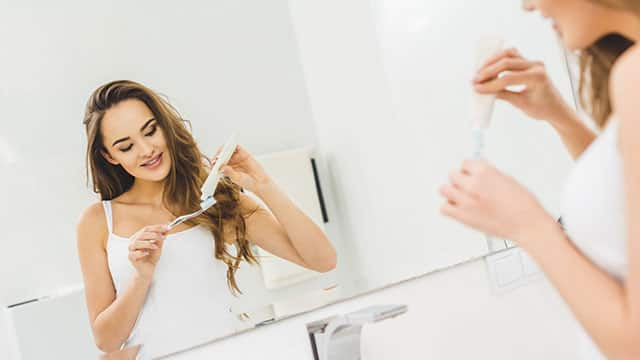Understanding Tooth Discoloration
Dental professionals categorize tooth discoloration into two types: intrinsic and extrinsic stains. Intrinsic stains occur inside the tooth — within the enamel or the dentin beneath — and are caused by aging, genetic disorders, and other issues. On the other hand, extrinsic stains occur on the tooth's surface, usually from exposure to highly pigmented foods and beverages or tobacco.
How Does Brushing Your Teeth Make Them Whiter?
Removing intrinsic stains requires the use of bleaching agents, such as carbamide peroxide or hydrogen peroxide. However, you can reduce extrinsic surface stains through mechanical efforts — such as brushing your teeth.
Your enamel looks shiny and smooth, but it’s actually filled with tiny pores that are invisible to the naked eye. Color pigments from strongly colored foods, drinks, or tobacco smoke, for example, can become embedded in the pores of your enamel, leaving behind stains and discoloration. However, when you brush your teeth twice a day, these pigments are scrubbed away.
Stains can also set up home on your teeth via plaque. In the same way that this sticky substance attracts bacteria and food debris, it can also cling onto color pigments and take on their hue. Brushing twice a day is the number-one way to keep plaque at bay, keeping your teeth white in the process.
So that's how brushing can whiten your teeth. But to get the brightest results from your brushing habits, it’s important to have the right tools and techniques for the job…
Choose the Right Toothbrush
Did you know using the right toothbrush can help keep your teeth clean and white? The ADA recommends a soft-bristled toothbrush to gently clean and polish teeth without damaging your enamel or gums. Your brush should be small enough to fit comfortably in your mouth and move around so you can reach all your teeth with ease. Power toothbrushes can help improve your technique, allowing the brush to do most of the mechanical work for you.
Replace Your Toothbrush Regularly
The ADA recommends you replace your toothbrush every three to four months or even sooner. A worn-down and frayed toothbrush can't clean your teeth as well. So if you start noticing signs of wear, purchase a new toothbrush to lift stains and polish your teeth properly. That means throwing out a toothbrush with frayed bristles, even if it's before three months.
Use a Whitening Toothpaste
For the best results, add a whitening toothpaste to your oral care routine. Whitening toothpaste will contain abrasive ingredients — such as silica — to help scrub the tooth's surface. They also might include a low dose of a bleaching agent like hydrogen peroxide or carbamide peroxide to help whiten teeth over time. Ask your dental professional to recommend the best whitening toothpaste for you.

Pro Series Toothpaste
Created by whitening professionals, Colgate® Optic White® Pro Series Whitening Toothpaste contains our highest level of hydrogen peroxide (5%) in an over-the-counter whitening toothpaste.

Brush the Best Way
Want to know how to brush properly to get whiter teeth? Use the following advice to make sure your brushing is as effective as possible.
With your toothbrush at a 45-degree angle to your gums, gently brush your teeth using short, back-and-forth strokes. Concentrate on areas with surface stains, but make sure to brush all the surfaces of your teeth, including the insides. Also, brush your tongue to get rid of any lingering bacteria. Finally, don't forget to floss or clean between your teeth with an interdental device.
In addition to these techniques, maintaining bright and healthy teeth requires visiting your dental office for routine exams and cleanings. Achieving a whiter smile starts with good oral health, so make taking care of your teeth a priority.
This article is intended to promote understanding of and knowledge about general oral health topics. It is not intended to be a substitute for professional advice, diagnosis or treatment. Always seek the advice of your dentist or other qualified healthcare provider with any questions you may have regarding a medical condition or treatment.
ORAL HEALTH QUIZ
What's behind your smile?
Take our Oral Health assessment to get the most from your oral care routine
ORAL HEALTH QUIZ
What's behind your smile?
Take our Oral Health assessment to get the most from your oral care routine
Join Us
Get the best of your oral health routine and take it to the next level with expert advice, recommendations, products and solutions and special offers.
Join Us
Get the best of your oral health routine and take it to the next level with expert advice, recommendations, products and solutions and special offers.















